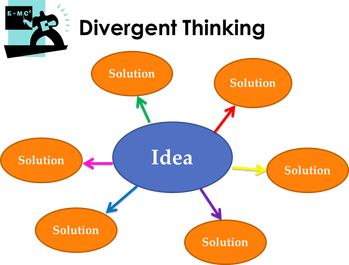 This week I provided students with an overview of the differences between convergent and divergent thinking. We discussed the importance (and inter-related nature) of both types of thinking skills for the development of strong critical thinking ability and problem solving. Students were then given several exercises to work on in small groups, aimed primarily at flexing their divergent thinking muscles. At first glance these seemed like simple, almost silly questions: 1) list all the possible uses you can think of for a screw driver; 2) the answer is 20, what is the question? However, the purpose of these types of exercises is to get students to e-x-p-a-n-d their thinking, use their imagination, and tap into the more creative problem solving side of their mind. Unlike convergent thinking, where we aim to zero in on one correct answer, divergent exercises such as these help us learn to generate many plausible solutions, and they push us to think more flexibly. Our lead-in exercise this week challenged the students to use scissors to cut a hole in an ordinary piece of paper through which an elephant can pass. Amazingly, what at first seemed impossible (or some sort of trick question!) ended up being solved, as the students talked it through, and asked questions, until obvious and simple statements such as “we need to make the paper really big” led to insights, which ultimately led to a successful procedure: “We can cut strips up and down inside the paper to make one huge hole!”. While we did not have time for all the students to create the enormous paper hoops, I was genuinely impressed with their collective ability to think through such a difficult and unusual problem. And as promised, the step-by-step instructions for cutting the paper are provided below. We also spent some time going over the homework problems from last week. These were very challenging, and I commend the students for the amount of time they devoted to working through them. Not everyone arrived at a solution for each problem, but it was clear to me that everyone had taken time to really think through possible approaches and answers. It is very valuable for the students to deeply engage in the thinking process, even if they do not obtain a solution to the problem. It is also important for them to articulate what approaches/strategies they tried and what process led to a solution for each problem. Some important observations the students made on thinking processes this week include the following: the solution to problem 1 (bacteria) becomes simple and obvious once you realize it is a problem of doubling - the initial amount of bateria in the cup is irrelevant, although students felt at first that it must somehow be important to the solution; problem 2 sounds impossible and confounding, until we have the realization that we need as much time to pass as possible between the uttering of the sentence and Peter's next birthday - then we can easily solve it by visualizing a calendar; problem 3 requires the most divergent thinking, as we must conceive that circles could be drawn on both sides of the paper (and the class even came up with several other plausible answers!); problem 4 (the magic square) requires the process of elimination and several iterations to arrive at the solution. I provided the students with three new problems to work on at home this week. These are similar to last weeks problems - tricky but fun! Read them over carefully and take your time thinking them through. I look forward to hearing your solutions and thought processes on Monday!
Comments are closed.
|
Categories
All
Archives
May 2016
|
||||||

 RSS Feed
RSS Feed